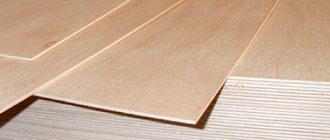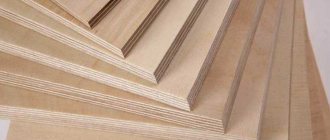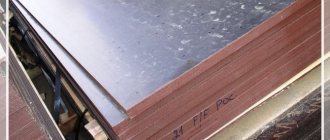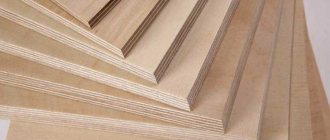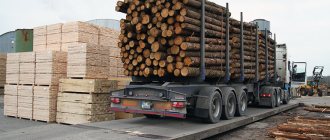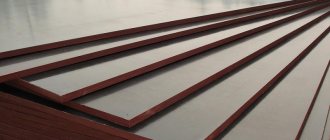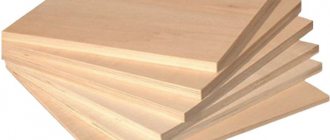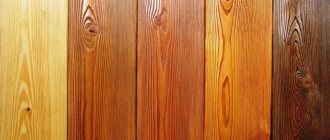A fairly profitable branch of small business is the production of veneer plywood. But in order to make good money in this area, you need to choose the right strategy and tactics for doing business. Knowledge of the topic and a clear, verified business plan will help with this. You should realistically assess the expected income, as well as the cost part and the purchase of necessary machines, and the optimal interest rates for obtaining loans, if needed.
The production of building materials from wood always brings a stable income. Today, the construction of private houses, summer houses, cottages, interior decoration, and the manufacture of various furniture cannot be done without the use of plywood sheets, and therefore plywood production is still a promising business.
Veneer plywood
A little about the range and types of material
Regarding processing, plywood sheets are divided into:
- unpolished (or NS),
- polished on one side (or Ш1),
- double-sided (Ш2).
And according to the amount of surface defects in the material, several grades are distinguished: starting with the elite (grade E), where there are no visible wood defects, ending with the 4th, which allows for almost any “appearance defects.” The product range is determined by the conditions of GOST No. 3916.1-96 for wood.
Plywood range
The brand is determined by the type of glue used:
- FSF – made using resin glue (phenol formaldehyde). It is water resistant and is used for interior work and in places of high humidity;
- FC – urea glue is used. Such veneer plywood with low water resistance swells quickly and may lose its shape;
- FB – impregnated with bakelite varnish (before assembly and gluing). Such wood sheets are used for work in adverse conditions; plywood can withstand the effects of lye, microorganisms, and sea water.
Laminated plywood. In its production, special coating compositions are used. This plywood optimally resists the effects of liquids and has a powerful reserve of wear resistance. It is used for trailers, containers, wagons, yachts; in the manufacture of furniture with equipment, in the finishing of buildings.
Plywood laminate
And also: according to its purpose, the material is divided into construction, aviation, automobile, ship, and the like. For finishing interiors, decorative plywood made from valuable wood species is now in favor.
Multilayer and multifunctional building material
To start producing plywood competitively, you will need high-tech modern equipment and the selection of qualified personnel.
Help
If the article is read by specialists, then more in-depth knowledge about plywood manufacturing can be obtained from me if you seek advice.
In addition, I can organize the supply of equipment and sell your equipment.
Often plywood manufacturers install their own resin production facility in their production. This allows you to reduce the cost of resin by 3 - 6 rubles. I wrote in my new book how to organize all this, gave very detailed information on how to weld the resin and what equipment is needed for this. The resin is suitable for both plywood and other wood boards and even sawdust timber. Read more about the book in the “BOOKS” section.
Good luck and see you again!
Techniques and prospects for making plywood
Birch and coniferous species are what this material is made from. The logs are brought to the factory and protected from bad weather and sun - so that ultraviolet rays do not dry out the ends. Take birch, for example—it makes the strongest plywood.
This type of wood is brought to production in the form of raw materials: sawn logs. They form something like a bundle, “intercepted” by a massive metal chain.
Birch logs - raw material for plywood production
These “fags” are carefully moved into a pool of hot water. Here the wood is steamed for some time.
Steaming of raw materials
And a brown foam comes to the surface. This natural substance is tar, which is released by birch.
Formation of tar
And after some time, the darkened logs will be unloaded from the pool and left in the open air to equalize the internal temperature - the heat should reach the very core of the wood. If you steam it well, it becomes plastic.
After the blanks are sent for peeling. The logs are wrapped around an axis on the machine, and a special knife removes the bark, removing wide shavings. The movement occurs along the so-called Archimedes spiral.
Chip removal
For reference: in the third century BC, Archimedes invented a formula for an ideal spiral - it should rotate evenly around a point, approaching it an equal distance with each turn.
The same spiral
This spiral allows you to cut perfectly even layers from workpieces. These same shavings that are removed from the logs are called veneer sheets.
The length of veneer sheets from one log (as blank logs are called) sometimes reaches fifteen meters. The veneer sheet remains warm and saturated with moisture (for some time). After all, if the logs are not steamed first, the veneer will begin to break during the peeling process and will be torn. The thinnest birch leaf is a millimeter thick.
Cutting a veneer sheet
By the way, in the States, where there are practically no birches, plywood sheets are cut from coniferous trees. And in the Middle Kingdom they use poplar.
The shavings are then cut on a special guillotine and sent to the dryer. A stream of hot air quickly removes excess moisture from the sheets so that the future material does not delaminate or bubble.
The repair machine cuts defects and at the same time puts patches in these places
Now comes the assembly time. For a sheet one centimeter thick, several layers of veneer are glued together. Previously, casein, a milk protein, was used for the procedure. Casein plywood sheet was strong, but it was not moisture resistant and quickly got wet.
Nowadays, veneer is mainly glued together using formaldehyde resin - the end result is moisture resistant. A plywood sheet has an odd number of layers (for example, five layers). Only even-numbered sheets are impregnated with glue, which during the assembly process should alternate with odd-numbered - dry ones. The main thing: the layers are arranged perpendicularly. This gives the plywood strength. So, in the first sheet the fibers will be located along, and in the second - across. Thus, the impact toughness increases, that is, the ability to absorb mechanical energy.
Veneer layers
The stacked layers are put into a press for a couple of minutes, first cold. There the dry, glued “spare parts” are set. This is the first stage, followed by hot pressing. Sheets of future plywood are loaded onto a lift into a hot press. Under pressure, the veneer is firmly glued together. Then, during the day, the sheets will cool down, and the polymerization processes of the adhesive base will be completed.
Now the uneven edges of the veneer are cut off, and the product is given its usual appearance.
Final version
Technology for the production of plywood from birch veneer - Machine tools, welding, metalworking
Plywood is one of the cheapest and most practical building materials.
Despite its multilayer structure, it is easy to install and can be processed at home without special equipment.
Standard plywood production involves the use of wood lamellas, which, if properly processed, can produce a finishing material that is resistant to a variety of threats.
Receiving veneer
Modern production uses several methods for cutting lamellas for plywood. Among them, peeling using a circular saw, planing of logs, as well as sawing them into thin strips stand out. However, the processes of planing and sawing, due to low productivity and efficiency, are increasingly being replaced by peeling.
For this operation, special machines are used that cut workpieces in cross section. The log is fixed on a circular base and, in the process of rotation around its axis, is cut with high-precision peeling knives. This is how the most critical stage in the plywood manufacturing process is performed, on which the main characteristics of the future product depend.
Finished strips of lamellas come out of the peeling machine. They are stacked and then sent for further processing.
Plywood production
Plywood production is currently a rather labor-intensive technological process. The history of plywood dates back to the 15th century BC.
The first mechanical machines for making plywood were invented in 1819 in England, by a Russian citizen, Professor Fisher. Since the creation of the first machine, the technological process of plywood production has improved significantly.
But in general, the manufacturing process is based on the same principles as in the first mechanical machines.
Wood selection
This stage is characterized by the selection and preparation of wood logs. Logs intended for making plywood are called veneer logs.
They are most often delivered to the processing site by rail. For production, both deciduous wood species can be used - birch, linden, alder, and coniferous species can be used.
Birch is the most commonly used hardwood tree.
This is largely due to the specific arrangement of annual rings in the structure of the tree trunk, as well as the small number of knots. In addition, birch has an average density of about 650 kg/m3. Thanks to these qualities, it is possible to produce various grades of plywood from birch veneer.
Business equipment
The number and quality of machines may vary, depending on the quantity of the intended product. But at a minimum, the following machines will be necessary:
- calibration, removes the top layers of wood;
- peeling, removes the main part of the veneer;
- cutting machine, cuts the canvas into sheets of the required size.
How much would it cost to purchase such equipment? For example, according to experts, today a semi-automatic line in a workshop can “cost a pretty penny”: you will have to pay from 50 to 65 thousand dollars. Well, or get a loan, then organizing a business in the production of plywood sheets will cost even more.
By the way, in addition to making regular ones, you can make, for example, laminated ones. The production and use of such a product is in great demand. And it consists of an additional step - covering the resulting material with a film.
general description
Depending on what surface was used, certain types of plywood can be distinguished. Thus, on sale you can find sanded, unsanded material, or one that is subjected to similar processing on one or both sides. These canvases can be made from different types of wood, among them poplar, birch, pine needles or aspen. You can also find a combined material that contains several types of wood material. Birch plywood is considered very durable. This is due to the significant physical and chemical properties of wood, which is supported by the multi-layer structure. As for the coniferous variety of canvases, they are made from pine, which provides high strength with low weight. These types of plywood are successfully used in the construction of houses. The grade of material is determined by the number of knots per square meter. Thus, on the building materials market you can purchase the described material in four grades.
Number of veneer layers
The second criterion is the number of veneer layers. It starts with three, and it is always odd. This is explained by the peculiarities of plywood production - to increase the mechanical strength of the sheet, the direction of the fibers of the veneer sheets during laying alternates, and the odd number allows you to maintain the same appearance on both sides. The exception is the four-layer one - in it the direction of the fibers of the two inner layers coincides, and the outer ones are laid perpendicular to the inner ones. In plywood factories, the required plywood thickness is achieved only by joining the required number of layers of veneer.
What is it used for?
The range of applications for plywood is truly enormous. It is used for cladding, formwork, for the production of furniture, packaging, sports and play equipment. Another unexpected area is the production of bodies for some vehicles, including in aircraft construction. Of course, such tasks require unusual plywood; we will consider this issue below.
Thinner varieties of plywood are used in modeling and creativity: the artist coats thin plywood with gypsum sealant as a primer, after which he can paint on such a sheet.

